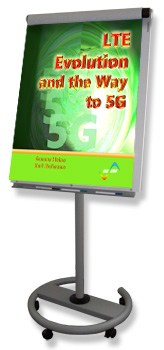 LTE Evolution and the Way to 5G
LTE Evolution and the Way to 5G
 Training Course Description
Training Course Description
 The main focus of this course is the evolution of the LTE system from LTE to LTE-Advanced (3GPP Rel. 10 and 11) and beyond.
The main focus of this course is the evolution of the LTE system from LTE to LTE-Advanced (3GPP Rel. 10 and 11) and beyond.- After a recap of the key parameter of the LTE access scheme, as well as MIMO, the course lists the motivating factors to migrate towards LTE-Advanced.
- As part of this section we elaborate how LTE-Advanced meets the ITU requirements for 4G systems. The section concludes by comparing LTE-Advanced with other radio solutions like WiMAX or WiFI.
- The enhanced radio concepts of LTE-Advanced, namely: carrier aggregation, enhanced multiple antenna techniques for downlink and uplink, coordinated multipoint transmission and reception (CoMP) plus mechanisms in order to reduce the latency are described in details in this section.
- The next section provides a detailed view on the architectural changes coming with LTE-Advanced. This includes the enhanced concept of Home eNodeB's (HeNB) and a detailed description of the operation and benefits of relay nodes.
- The following chapter outlines interworking options of LTE-Advanced with other Radio Access Technologies (RAT), namely GSM, UMTS, cdma2000 and WiFI. This section includes possible deployment scenarios and security aspects.
- The next chapter deals with the description, operation and benefits of Self Organizing Networks (SON), which have been partly implemented in LTE and have been developed alongside with the 3GPP releases.
- The final part provides an outlook beyond LTE-Advanced and pinpoints the current state of research on 5G and the related technologies and enhancements.
Some of your questions that will be answered
- Can HSPA+ ever be considered as a 4G technology?
- What are the 4G targets with respect to e.g. throughput rate and spectral efficiency?
- What is a component carrier?
- What are the main improvements of LTE-Advanced compared to LTE?
- How does LTE-Advanced meet or even exceed the ITU 4G requirements?
- Which other technologies are there to address the ITU-T's 4G requirements?
- How do intra- and inter-band carrier aggregation work in detail?
- What is Coordinated Multipoint Transmission (CoMP) and how does it work?
- How does LTE-Advanced address issues like access network security, if another access network type like WiFI or WiMAX is used?
- What is the concept of heterogeneous networks?
- What are the business drivers of SON and where can SON help?
- What is today's assessment on 5G and the related technologies?
 Who should attend this class?
Who should attend this class?
- The course is intended for people involved in engineering functions such as product management, design and deployment as well as those who need to understand LTE-Advanced and its position within the 4G wireless roadmap.
- Engineers and technical staff who require detailed inside knowledge of the LTE-Advanced standard and technology.
 Pre-Requisites
Pre-Requisites
- The student must possess a thorough understanding of the LTE system.
- Long year experience with mobile radio systems such as UMTS, HSPA or GSM/GPRS is required to be able to follow the course.
- We recommend our course "LTE from A-Z reloaded" to be taken upfront this course.
 Training Course Target
Training Course Target
- The student will obtain detailed understanding of the leapfrogging from LTE to LTE-Advanced which enables her or him to contribute efficiently to all related job assignments.
- We enable the student to think beyond 4G and have an idea of the current state of research on 5G mobile networking.
- The student will be able to specify and describe the key features of LTE-Advanced and compare LTE and LTE-Advanced.
- The student will be able to describe possible interworking scenarios of LTE-Advanced with other radio access technologies.
 Training Course Duration
Training Course Duration
- 2 days
v1.0
ℹ️ Try out the updated search below!
Search:
More Info:
Detailed ToC of this training course
INACON eBooks
Please have a look at our full offer

